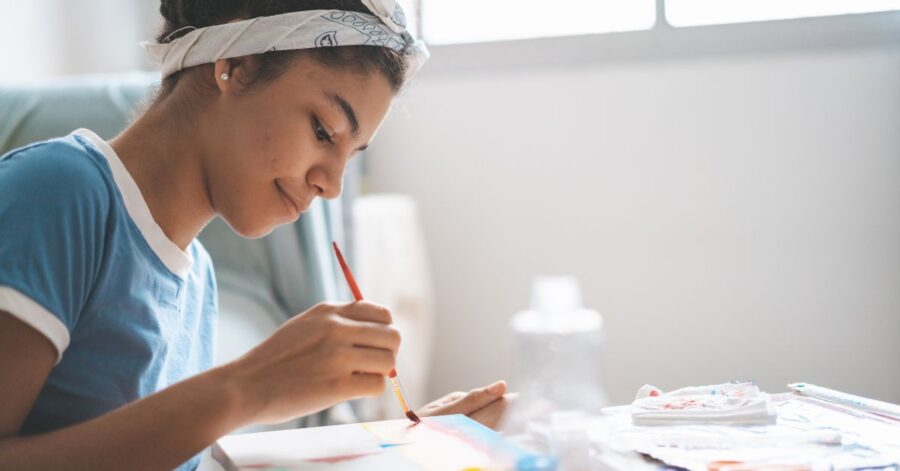“Truth, beauty, and goodness” are terms you’ll find in the books about classical education. Sometimes, they seem too abstract to implement in our homeschool. If you put your high schoolers in “beauty school,” they won’t be taught the transcendental value of Biblical beauty!
I had a hard time wrapping my mind around the three, but Russ Ramsey explains them well in his book, Rembrandt is in the Wind, saying, “They are three properties that define God’s nature.” That makes them seem even more important to teach: they might draw our students closer to knowing God.
I thought truth and goodness were fairly approachable. Incorporating truth into homeschooling can be done with proof. For example, in math, we say 2 + 2 = 4 because if you have these 2 apples, and I give you 2 more, we count four all together. Truth relates to reality and reason. Goodness is taught by modeling and expecting good behavior and reading great literature about characters who do what is good. Goodness relates to fulfilling purpose.
What Is Beauty?
But what about beauty?
Modern and post-modern art has probably made you question the definition of beauty. “If it is hanging in the art museum, it must be good,” you think. Once you’re there, though, what you see in the modern art section is often not at all beautiful, and you conclude that you don’t know what beauty is.
I propose that you were right the first time and the curator of the modern section is wrong. If you are created by and made in the image of God who is beauty and created beauty, you can recognize beauty: that which is lovely. (See the correlation between beauty and love?)
Beauty is a sense of glory. It is that thing that takes your breath away when you see it. It touches your heart.
I remember when I saw the sun rise above the rim of the Grand Canyon. I gasped at the grandeur of the canyon and the colors in the sunrise.
I was similarly awestruck the first time I saw the real statue of David in Florence, Italy.
Beauty is what draws you to God. It is the thing that makes you sing, “Praise God from whom all blessings flow!”
Beauty also inspires creativity, and creativity is going to help your student grow up to be a creative problem-solver no matter what field he or she goes into.
Beauty in Your Home School
How, then, can we incorporate beauty into our home school? Good news: If your family has chosen to homeschool your kids (or even if you’re still thinking about it), you can take advantage of having a more flexible schedule to share the beauty that God has created.
Load it.
Go to national parks and botanical gardens and look around. Take your kids to the symphony kids’ programs. Go to art galleries (skip over the modern art until you’ve had a chance to explain that it’s a reflection of a post-modern worldview, not a Biblical one.)
Learn to linger.
Drawing something beautiful will cause you to look very closely at the lines and shapes. Painting something will cause you to look very closely at the colors. Discussing what you see can help you learn terms for beauty: line, symmetry, texture, etc.
Create it.
God is a creator. We’re created in his image. Therefore, we were created to create. Children enjoy creating when they’re young, and all you have to do is encourage them. (Schools typically, unintentionally, discourage creativity, so don’t fall into what you may have been exposed to if you were in a traditional or government school. Be intentional about encouraging creativity.)
Delightful Art Co.: For Further Explorations in Art and Beauty
If you’d like some help with incorporating beauty into your home school, check out my live, online art class, Paint Your Way Through Art History, in which I walk through each period of art and explain the worldview and how it’s evident in the art.
I also teach fine art skills in drawing and painting and give your student inspiration for creating their own artwork based on the artist or period. They create their own art history book by working in a blank art journal each week throughout the school year. This will give your student a better understanding of why there are things that aren’t beautiful in the art museum. They will learn to evaluate ideas and consider whether the idea is Biblical or not. I pull in architecture and design as well, making this my most important and popular class for high school students.
I also have classes for younger students. Each class enhances another academic subject, so art will help your student learn the vocabulary and concepts of the academic subject. They’ll create their own book on the subject. It may even help your student learn to love a subject by making it more experiential. A very popular class for Classical Conversations students is our foundations-specific art and history class, which will be Ancient History and Art this year.
If your kids are enrolled in the Classical Conversations homeschool program, they learn that God is at the center of all things: science, math, and, of course, art. For more information, please visit www.delightfulartco.com/cc-match-up.




